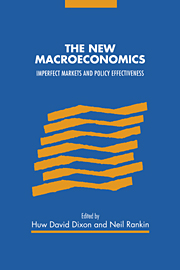Book contents
- Frontmatter
- Contents
- List of contributors
- Preface
- Acknowledgements
- Introduction
- Part I Overviews and perspectives
- Part II Goods market imperfections
- Part III Labour market imperfections
- 7 Demand uncertainty and unemployment in a monopoly union model
- 8 Efficiency wages as a persistence mechanism
- 9 Efficiency, enforceability and acyclical wages
- 10 Business fluctuations, worker moral hazard and optimal environmental policy
- Part IV Financial market imperfections
- Part V Nominal rigidities and bounded rationality
- Bibliography
- Index of authors
- Index of subjects
8 - Efficiency wages as a persistence mechanism
Published online by Cambridge University Press: 13 October 2009
- Frontmatter
- Contents
- List of contributors
- Preface
- Acknowledgements
- Introduction
- Part I Overviews and perspectives
- Part II Goods market imperfections
- Part III Labour market imperfections
- 7 Demand uncertainty and unemployment in a monopoly union model
- 8 Efficiency wages as a persistence mechanism
- 9 Efficiency, enforceability and acyclical wages
- 10 Business fluctuations, worker moral hazard and optimal environmental policy
- Part IV Financial market imperfections
- Part V Nominal rigidities and bounded rationality
- Bibliography
- Index of authors
- Index of subjects
Summary
Introduction
This chapter explores a dynamic extension of the efficiency wage model of Shapiro and Stiglitz (1984). The main result is that the efficiency wage model can generate hysteresis. This is an important result because it is usually thought that hysteresis can chiefly be explained by the insider-outsider theory of unemployment, as in Blanchard and Summers (1986). In part for this reason, it is often considered that the efficiency wage model is a good model of the natural rate of unemployment but that it has little to say about its dynamics. This chapter builds a model which shows that this assessment is incorrect. The intuition behind the hysteresis result is that when a firm's employment is expected to shrink, workers have a greater incentive to shirk. In order to prevent them from doing so, it is necessary for the firm to raise future wages. This will generate an incentive to limit the number of people it will lay off. Hence the firm's employment will have a tendency to stay where it is, because deviations from the current value are costly in terms of incentives. More specifically, we build a model where effort inducement generates a cost function which is kinked at the current level of employment, implying corridor effects in the same fashion as is obtained in models with linear adjustment costs.
Previous work on business cycles and efficiency wages (including Strand, 1992a and Danthine and Donaldson, 1990) has focused on the effect of efficiency wages on employment variability.
- Type
- Chapter
- Information
- The New MacroeconomicsImperfect Markets and Policy Effectiveness, pp. 186 - 205Publisher: Cambridge University PressPrint publication year: 1995
- 1
- Cited by

